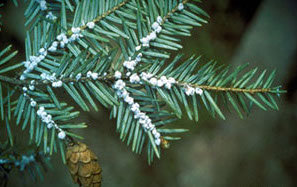Huyck Preserve imports silverflies to try to save hemlocks
RENSSELAERVILLE — Can a Pacific Northwest silverfly save eastern hemlocks in New York State? The Huyck Preserve in Rensselaerville is leading the way in finding out.
It’s called biological control, and it means putting a natural predator near its prey as a way of managing a pest — in the way that lady bugs killing aphids, or deer mice eat gypsy moths.
The Edmund Niles Huyck Preserve, an accredited land trust with over 2,000 acres and a biological research station, is working with the New York Hemlock Initiative at Cornell University to implement biological control of the hemlock woolly adelgid, a destructive pest of eastern hemlock trees from Asia that was introduced in Virginia in the early 1900s. Since that time, adelgid has killed millions of hemlocks from northern Georgia to Nova Scotia.
The Huyck Preserve is a partner in the Capital Region Partnership for Regional Invasive Species Management, a not-for-profit quasi-governmental agency hosted by the Cornell Cooperative Extension of Saratoga County and funded through the state’s Department of Environmental Conservation via the Environmental Protection Fund.
In 2018, the Huyck Preserve began work on its first invasive-species management and monitoring plan, according to a release from the preserve, and Capital Region PRISM (Partnership for Regional Invasive Species Management) became a significant resource for protecting the lands and waters of the preserve from the harmful effects of invasive species, including forest pests like hemlock woolly adelgid.
The Huyck Preserve undertook its first chemical treatment of woolly adelgid in 2020. But the pest has continued to spread across the nearly 350 acres of hemlocks at the Huyck Preserve. This spring, the New York State Hemlock Initiative released two species of silverflies, Leucopis argenticollis and Leucopis piniperda. These tiny flies are native to the Pacific Northwest of the United States and are specialist predators of the woolly adelgid.
In other words, they feed only on the adelgid and are at very low risk of causing ecological problems. The silverflies feed on adelgid eggs as larvae and are some of their most numerous predators on the western hemlocks of the Pacific Northwest.
This year’s release is part of a long-term study coordinated by the three organizations, and future monitoring will determine the success of establishment of silverfly and control of the adelgid. Only time will tell if the release of a small number of silverflies (compared to the vast infestation of the hemlock wooly adelgid at the preserve) is successful.
Although systemic insecticide treatment is currently the most effective method in managing the adelgid, long-term, landscape-scale conservation of hemlocks will likely depend on biological control. Eastern hemlock is New York’s third most common tree species and is a foundation species in its forests. Hemlock trees are important for maintaining healthy wildlife habitat and freshwater resources, and their loss would drastically change the landscape.
Advice from the DEC
The state’s Department of environmental conservation says citizens can help slow the spread of the hemlock woolly adelgid by cleaning equipment or gear after it has been near an infestation, and by leaving infested material where it was found.
The department is also calling on residents to report infestations in towns where the pest has notyet been confirmed. This includes two towns in Albany County: Westerlo and Berne.
The DEC asks that pictures of the infestation signs with something for scale such as a coin or ruler be taken, noting the location, and that the hemlock woolly adelgid survey form be filled out.
The report and photos are to be emailed to DEC Forest Health at foresthealth@dec.ny.gov or observers may call the Forest Health Information Line at 1-866-640-0652 instead.
If residents have trees that are infested with the hemlock woolly adelgid, they are urged to visit the Hemlock Initiative website for tips on how to manage the infestation with chemical treatment. The identification should be confirmed first so that DEC is notified in case it is a new town detection and because best treatment practices vary greatly among common hemlock issues.
— Melissa Hale-Spencer


